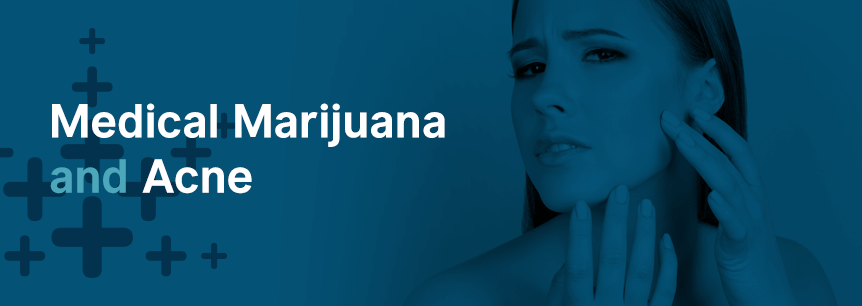
There’s nothing typical about acne. Although it is the most common skin condition in the United States — 50 million people struggle with it each year — it is a condition that often gets misunderstood and under-treated. Acne has a reputation for being a teenager’s problem, but it actually affects adults of all ages. In fact, there has recently been a rise in the number of adult women who struggle with acne.
While acne is not a life-threatening condition, it does have a significant impact on an individual’s overall health and well-being. In fact, over time, people with severe acne are at risk of developing low self-esteem and depression. Understanding acne and the treatment options available for it can be an essential first step to improving someone’s overall quality of life.
Medical marijuana has a reputation as an effective painkiller, but did you know it can also work wonders on acne? In 2014, the Journal of Clinical Investigation found that CBD — a marijuana compound with significant medical benefits — can regulate the amount of sebum, or oil, the skin produces, even finding CBD can control oil without drying out skin. More recently, another study designed to observe how skin reacted to CBD-based products found 100 percent of participants had noticeably better skin in just two weeks. This study was particularly notable because it is rare to have such a vast percentage of a study sample experience the same results. Besides the notable results, the amount of time it took to see improvements was just a fraction of the time it takes for over-the-counter treatments to kick in.
CBD-infused products produce notable results in skin care, including offering significant anti-aging properties, but they are also known for decreasing stress, which can contribute to acne breakouts in the first place. They also have the potential to treat serious skin conditions such as psoriasis.
Find A Doctor Find A Dispensary
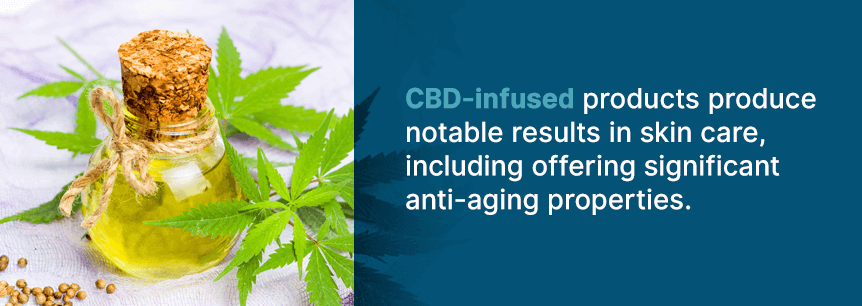
There may be some confusion over the success of using cannabis to treat acne because there is a lot of mixed information online about whether or not smoking marijuana causes acne. Some say smoking helps individuals relax, reducing the stress that can cause acne. Others say THC can increase hormone levels and increase acne. Products high in CBD, such as lotions, creams, oils, and other topical or edible applications, are the ones known for their skin-improvement properties. While the research is still lacking, everyone can agree there is increasing evidence that CBD-infused products show significant promise in skin care, specifically regarding their ability to control and reduce acne.
If an individual opts for marijuana rather than a CBD-infused product, several strains of marijuana have a higher concentration of CBD, therefore providing more benefits to the skin. These include:
With a 5:2 ratio of CBD to THC, this strain produces a small buzz but not the extreme high of other products. Its most significant benefits are an overall improvement in mood and anxiety. While that may not directly help with acne, it can reduce the stress and low self-esteem that may come from worrying about acne.
This strain of marijuana is high in CBD and known to treat arthritis and PTSD as well.
This strain was one of the original CBD-heavy offerings out there. Because there is almost no THC in it, it does not produce a high, but it still offers the other benefits of smoking marijuana.
Sour Tsunami has more CBD than THC, although the exact percentages of CBD may vary between products. It also has a reputation for its painkilling properties.
This one is known for its ability to relieve stress, as well as increase motivation and improve moods.
Unfortunately, acne is not yet on the list of health conditions medical marijuana use can legally treat. But the good news is that the CBD-infused products that are most effective in treating acne are available for purchase in all 50 states as long as they come from industrial hemp — a close relative of marijuana. In states that have legalized marijuana, stronger versions of these products are available as well.
Skin care products containing CBD are vast and include a variety of day and night creams, gels, serums and more. Besides treating acne, many of these products offer anti-aging properties as well.
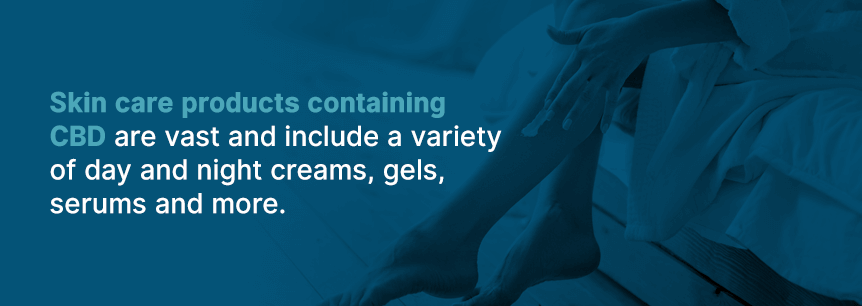
There is little information available about the possible side effects of CBD-infused products. While they are gaining popularity among users and physicians, to date, researchers have only conducted a limited number of scientific studies on their properties and effects. That is due, in large part, to the fact that marijuana is still illegal on the federal level, limiting what funding is available for research in this field.
At this time, the most prominent side effects of using cannabis-related products for acne treatment include:
There are mixed opinions on whether smoking pot helps or hurts the condition of the skin. However, smoking, in general, is known to age skin, so smoking a joint for acne might not be the best way to receive the relief and repair skin may need. If a person opts for regular smoking over a long period, they may want to consider replacing their joint with a vaporizer or bong. Using other products that do not require smoking also prevents potential harm to the skin.
Because there is little to no regulation within the industry, there are no rules governing product descriptions and labels. Not only that but the contents of products, including the amount of CBD, vary from brand to brand. It’s essential for an individual to do their homework, understanding what’s in the product before purchasing and knowing how much CBD comes in each dose.
Weed has a reputation for increasing appetite, generally causing people to crave unhealthy snack foods that can be bad for the skin. So, while the jury is still out on whether or not smoking a joint will help or hurt directly, it can indirectly contribute to behaviors that are known to cause or intensify acne.
At this time, acne is not on any list of medical conditions that qualify for the use of medical marijuana. Some CBD-infused products are available online. However, those with stronger doses or products that contain THC are still not considered legal in all 50 states.
Research continues into the impact marijuana and related products can have on skin care. At this time, several promising studies point to its ability to heal and prevent acne, as well as act as an anti-aging agent. As more research occurs, marijuana and CBD-infused products are poised to offer cutting-edge skin care applications.
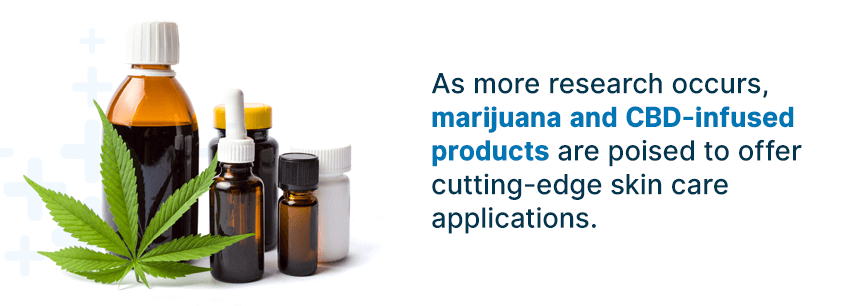
While the benefits to marijuana skin treatment may seem relatively clear-cut, individuals considering using these products to control acne or other skin conditions will most likely have a lot of questions. Patients should not be afraid to talk with an experienced medical marijuana doctor or the staff at a reputable dispensary, and these same professionals should continue to keep themselves abreast of advances in research as more studies take place in this area.
If you’re ready to learn more about medical marijuana and related topics, search for a medical marijuana doctor or dispensary in your state. Don’t wait any longer to improve your quality of life!
Find A Doctor Find A Dispensary
Acne is the umbrella term to describe an inflammatory skin condition in which pimples and spots appear on the face, back, buttocks, shoulders, neck, chest or arms. Acne occurs when dead skin cells collect in the pores. When combined with oils and bacteria on the skin, the pores become clogged and inflamed. The result is one or more large red spots that appear in inconvenient places.
Acne is most common among teenagers because the hormonal changes they are experiencing may cause an increase in oil production, meaning their skin has more oil on it and their pores become clogged more readily. However, it can also happen to young children — babies often experience “baby acne” — as well as adults of all ages. Because acne comes, in large part, from a shift in hormones or stress, it can happen to anyone at any age.
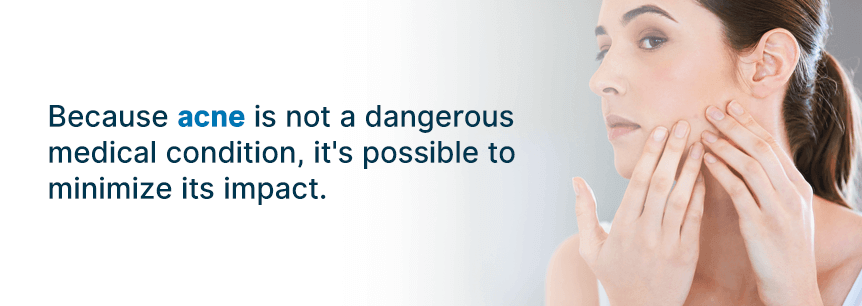
In general, acne results from increased oil production in the skin. However, several things can aggravate it, including:
While acne does produce pimples — medically referred to as “pustules” — the term refers to more than just an occasional blemish. Acne can include:
Pain or discomfort can also occur.
While it does often show up on the face, it can appear anywhere on the body. Because acne is not a dangerous medical condition, it’s possible to minimize its impact. However, adolescents and adults who struggle with acne have been shown to experience:
Some people find their acne embarrassing, especially when it is in a visible location like their face. It can impact their overall opinion of how they feel about themselves and cause them to avoid social situations. In teens, this can lead to missed school and a slip in grades. In some cases, it can spiral beyond a sense of low self-esteem. In some cases, acne sufferers struggle with depression, believing their acne makes them less valuable. Studies have shown teens with severe acne are more likely to consider suicide.
Acne can leave behind dark spots that can take months to disappear. In some cases, they don’t disappear at all. Scarring is most common among people who have acne nodules or cysts, which tend to be deeper in the skin and more painful than acne’s other forms. If left untreated, it can leave behind unsightly and permanent marks and scars.
Since acne is the most common skin condition in the United States, there are several treatment options.
In minor cases of acne, an over-the-counter soap, lotion or gel may do the trick. Lotions and creams, such as the ones often advertised on television, tend to work best in individuals with sensitive skin, while gels — which tend to dry out skin — can help individuals who struggle with excess oil on their skin. Most over-the-counter products contain one of these medications:
While all these medications have known benefits to treat acne, they have downsides, too. For example, when rubbed against sheets or towels, benzoyl peroxide leaves permanent stains. These treatments also do not provide an overnight change. It can take anywhere from four to eight weeks for an over-the-counter remedy to produce noticeable results. Even after the skin clears, people with acne must continue these treatments to maintain clear skin. And, in cases of moderate to severe acne, these treatments may not be enough.
When acne is moderate or severe, a dermatologist may prescribe a topical or oral antibiotic. Antibiotics reduce inflammation by decreasing the bacteria causing the acne. However, these medications are only recommended for up to six months, which means they are not for long-term use. And, although it is not incredibly common, acne can grow resistant to the antibiotic over time. For someone struggling with chronic acne, this can present treatment challenges.
Dermatologists can also prescribe a prescription-strength cream or gel. These contain ingredients similar to the ones available at the drugstore but in stronger amounts.
Some women rely on oral contraceptives to control severe acne. They work by suppressing the gland that produces the oil causing their acne. While this can be a more long-term solution — women don’t have to stop taking them after six months like other acne medications — oral contraceptives are not for women who:
An injection is an option for people who suffer from cysts. A dermatologist can inject the corticosteroid into the cyst, which speeds up healing and prevents scarring.
Retinoids come in two forms — topical and oral. Derived from vitamin A, topical retinoids unclog pores so blackheads and whiteheads cannot develop. Oral retinoids — called isotretinoin — are a powerful treatment limited to individuals with severe cysts that have not responded to other medications. While these are sometimes necessary, they can have potentially dangerous side effects, and doctors only give them to patients who sign a waiver saying they understand the risks they are taking by using it.
Individuals who suffer from moderate to severe acne will likely need more treatment, but for individuals whose acne is light, at-home treatments and remedies can be useful in controlling and preventing their acne. These include regular face washing, changes in diet, reducing stress and switching makeup and self-care products. Tea tree oil has also been shown to be an effective acne treatment.